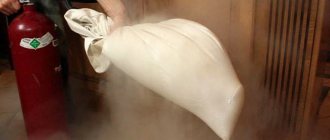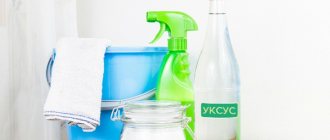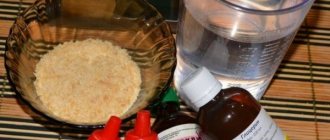A mirror is an integral household item in human life. It is impossible to imagine the interior of an apartment or a handbag without it. But over time and improper care, the appearance loses its reflective ability. Chips, scratches, and amalgam peeling often appear on the inner surface of the mirror.
It is impossible to imagine the interior of an apartment or a handbag without it.
Often in antique mirrors the glass itself is already so cloudy that it simply does not make sense to repair, preserve, or polish it.
Although all the ingredients for restoring a mirror surface are freely sold in pharmacies and stores, you will not be able to create a smooth mirror surface on your own the first (or even the fifth) time.
If the mirror is badly broken, then, of course, it is better to dispose of it. Because it is simply impossible to restore a broken mirror at home - this is a labor-intensive and hazardous technological process using mercury. But you can repair minor damage with your own hands.
A mirror is an integral household item in human life.
The original table accessory is ready; it will last for many years and will be a worthy part of any interior.
If the frame of the mirror is wooden and has lost its shine, you can update it by applying varnish of the required color.
Benefits of DIY restoration
What are the advantages of restoring a mirror with your own hands?
- Not every city and town has a restorer who knows how to restore damaged amalgam.
- Repairing a mirror coating is labor-intensive and requires investment, so mirror restoration will probably not be cheap.
- Time is wasted in searching for a restorer, delivering the item to him and back home, and on the way the mirror may break due to improper transportation. Therefore, it is easier to repair minor damage at home using improvised means.
Chips, scratches, and amalgam peeling often appear on the inner surface of the mirror.
Restoring a mirror with your own hands is quite accessible to a home craftsman.
Or change the look of the mirror by decorating it with jewelry, shells, bamboo sticks or broken dishes.
Causes of wear
Sometimes, after several years of service, we notice that the mirror does not reflect well and some spots appear. Turning the canvas over, it turns out that the coating has been torn off from the back side. It's called amalgam.
This coating can come off for various reasons. And these are not necessarily the consequences of scratches and mechanical stress. Amalgam also begins to slip if normal air circulation on the inside is disrupted. If you see transparent spots on the reflective side, you should think about gluing the mirror correctly or choosing a different place for it.
The production of mirrors is technologically quite complex. To create a reflective surface, a thin layer of metal, supplemented with special additives, is applied to the reverse side. Metal microparticles are gradually applied to the surface, often in several layers.
It will not be possible to achieve the same effect at home without special industrial equipment. Therefore, if your antique mirror in a wooden frame has worn out and lost some of its reflective properties due to peeling amalgam, partial restoration will be required.
No one is stopping you from giving the product to a special company, where they will do professional restoration. But it is very expensive and not every city has such specialists. The cost of the service sometimes exceeds the price of the mirror itself. First, you should try to perform the procedure yourself, at home.
Practice clearly shows that it is possible to restore a surface using available materials, and the result often exceeds expectations.
Methods for restoring a mirror surface
Depending on the damage to the amalgam, different methods and materials for restoration will be used. For minor damage, silicone sealant is used, and large areas are restored using foil and glue.
If the mirror is badly broken, then, of course, it is better to dispose of it.
A simple mirror restoration can be done at home; this will eliminate minor scratches, or at least make them less visible.
It all depends on the owner’s imagination.
Wardrobe decor with full color posters
Wardrobe doors with photo printing are not a cheap pleasure. Color posters based on vinyl film are much more affordable and often look much better. This is achieved through high quality printing. You can paste a poster on one of the doors or make a composition on all panels of the wardrobe.
Drawings on color posters can be very diverse: from abstract figures to your own photographs of memorable places. They should be applied like regular vinyl stickers.
Materials and tools required for mirror restoration
For major damage:
- glue for metal and glass;
- brush;
- soft fabric;
- glass cleaner;
- gasoline or alcohol-containing product;
- foil;
- brush;
- scissors;
- sponge.
But you can repair minor damage with your own hands.
Polishing, as a separate method of mirror restoration, is also performed in case of clouding of the reflective surface.
In modern interiors, mirrors often play an important role.
For small scratches and chips:
- water;
- alcohol;
- sponge, soft napkins;
- silicone sealant.
But over time and improper care, the appearance loses its reflective ability.
If abrasion or a shallow scratch appears, the mirror can be ground, and the top layer is removed from the reflective plane using coarse abrasives.
Mirrors not only have a utilitarian meaning, but also serve to decorate the interior and visually enlarge the space.
Prevention measures
Caring for a mirror surface should include the following points:
Carrying out regular cleaning using special products or homemade compounds;- exclude exposure to abrasive or other surfaces, including the hard sides of sponges;
- It is advisable to have complex damage and chips repaired by a specialist;
- mirrors do not tolerate constant moisture well, so mirror surfaces that fog up in the bathroom must be wiped dry regularly;
- Rubbing the mirror with shaving foam will help prevent the mirror from fogging.
Any dirt that gets on the mirror must be removed immediately.
Step-by-step instruction
How to restore a mirror with large amalgam damage?
You need to carefully remove the mirror from the frame and place it on a table covered with a soft cloth. Thoroughly clean the damaged surface with a brush. Then wash with glass cleaner and dry. Now degrease the damaged area with gasoline or alcohol and dry again. Using scissors, cut a piece of foil slightly larger than the size of the damaged area. Apply glue to the treated area of the mirror, apply the foil with the shiny side down and press. Use a napkin to smooth the surface of the foil from the center to the edges. Carefully remove excess glue with a sponge and dry the mirror for several hours. Place the restored mirror back into the frame.
Repairing a mirror coating is labor-intensive and requires investment, so mirror restoration will probably not be cheap.
To restore the surface of a mirror that has minor damage, grinding and polishing are used.
Special means
To perform work to improve the condition of the mirror surface, special preparations can be used.
Paste GOI
GOI paste is a special composition for grinding work . The main component is chromium oxide. The paste is used very widely - not only for caring for mirror surfaces, but also for polishing:
- glass,
- ceramics,
- metal alloys, etc.
How to use:
- grind the substance into powder;
- using a cotton swab, apply the drug to the damaged areas in a thin layer;
- rub and polish each area for at least a quarter of an hour.
Polishing with GOI paste must last for 15 minutes for there to be a visible effect; the exposure time cannot be shortened. The price for 20 grams is on average 50 rubles.
Cerium oxide
Cerium oxide is a chemical compound that can be purchased in powder form . This substance is used in ceramics, for processing jewelry stones, removing scratches on mirrors, etc. The product is available in packaging of various weights.
To repair a mirror and eliminate defects, cerium oxide is diluted to form a paste. The surface requiring treatment is moistened and the prepared composition is applied.
Periodically moistening the surface, polish with a felt cloth. Adding water helps prevent premature hardening of the mass. If necessary, add “gruel” and continue rubbing. Price for 0.1 kg is about 500 rubles.
How to restore a mirror with scratches and chips
Using a solution of water and alcohol, thoroughly rinse the damaged surface of the mirror and dry with napkins. Now carefully fill the scratch with sealant and let it dry. Remove excess from the surface and place the mirror in the frame.
As you can see, restoring a mirror at home is not a labor-intensive task and does not require much expense or time.
Small damages are easier to repair at home using improvised means.
But it should be noted that there are cases so serious that restoring a mirror costs more than buying a new mirror.
Is it possible to repair old canvas?
The process of mirror restoration is very painstaking . Many experienced specialists in this field can not only collect the fragments, but also restore complete integrity. Dust from the inside, clouding, scratches, amalgam defects - all these damages can be eliminated independently using a minimum of tools that every home craftsman has.
But you should understand that in exceptional cases, inserting a new mirror into the frame is much more profitable than restoring the former beauty of the old canvas. Expensive and complex restoration is very rarely applied to museum exhibits that have historical value.
But if the mirror is slightly damaged, then it is stupid to throw it away, so in case of minor defects, it is advisable to restore the surface with your own hands .
If you use the right chemicals and abrasives, the mirror will shine like new. The main criterion is a correctly calculated dosage and a little effort.
Decorating a mirror
If the frame of the mirror is wooden and has lost its shine, you can update it by applying varnish of the required color. Or change the look of the mirror by decorating it with jewelry, shells, bamboo sticks or broken dishes. It all depends on the owner’s imagination.
Restoring mirrors is a rather painstaking task, the result of which should be the preservation of the original surface, especially if the mirror is antique.
Depending on the damage to the amalgam, different methods and materials for restoration will be used.
For minor damage, silicone sealant is used, and large areas are restored using foil and glue.
If deep damage
More difficult work awaits if the scratches on the glass are deep. Simple rubbing in this case will be ineffective. A recipe using GOI paste and epoxy glue will come to the rescue.
Work order:
- Clean the mirror using glass cleaner. This will degrease the surface and prepare it for further processing.
- Dry the mirror.
- Fill the cracks with epoxy glue. When filling cracks, the epoxy should be distributed evenly, without air bubbles or unfilled cavities.
- Excess filler should be removed with a cotton swab or carefully cut off with a utility knife.
- Leave for 4 days.
- Polish the surface using GOI paste.
If the surface damage is very serious and you cannot fix it yourself, you can contact a specialized workshop.











